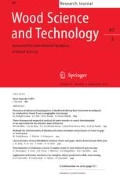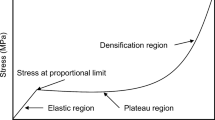Abstract
The paper describes for the first time the analysis of the structure of compressed wood using computed tomography. The anatomical structures of Douglas-fir and hybrid poplar before and after densification with the viscoelastic thermal compression (VTC) process were described by pore size distributions and mean pore sizes and compared. The compression of Douglas-fir mainly affected earlywood, while the compression of hybrid poplar mainly occurred in the vessels. In both wood species, the densification resulted in a significant decrease in the pore volumes. The porosity decreased to less than half of the original value for Douglas-fir earlywood and to approximately one-quarter for the vessels in hybrid poplar. The relevant mean pore sizes also decreased dramatically to about one-quarter compared to the original values. In contrast, latewood in Douglas-fir and libriform fibers in hybrid poplar are quite stable under compression. Douglas-fir latewood retained its original structure after compression and did not show any reduction in pore size. The results confirmed that the anatomical structure of VTC densified wood can be described by pore size distributions and mean pore sizes. However, in the case of broad or bimodal distributions, the mean pore sizes are of less significance.






Similar content being viewed by others
References
Balatinecz JJ, Kretschmann DE (2001) Chapter 9: properties and utilization of poplar wood. In: Dickmann DI, Isebrands JG, Eckenwalder JE, Richardson J (eds) Poplar culture in North America. NRC Research Press, Ottawa
Barnett JR, Bonham VA (2004) Cellulose microfibril angle in the cell wall of wood fibers. Biol Rev 79(2):461–472
Blomberg J, Persson B (2004) Plastic deformation in small clear pieces of Scots pine (Pinus sylvestris) during densification with the CaLignum process. J Wood Sci 50(4):307–314
Clair B (2010) Maturation stress in developing tension wood. Plant physiology preview. Am Soc Plant Biol 123(3):1650–1658
Dadswell HE, Hawley LF (1929) Chemical composition of wood in relation to physical characteristics. A preliminary study. Ind Eng Chem 21(10):973–975
Derome D, Griffa M, Koebel M, Carmeliet J (2011) Hysteretic swelling of wood at cellular scale probed by phase-contrast X-ray tomography. J Struct Biol 173(1):180–190
Dogu D, Tirak K, Candan Z, Unsal O (2010) Anatomical investigation of thermally compressed wood panels. BioResources 5(4):2640–2663
Dwianto W, Morooka T, Norimoto M, Kitajima T (1999) Stress relaxation of Sugi (Cryptomeria japonica D. Don) wood in radial compression under high temperature steam. Holzforschung 53(5):541–546
Fang CH, Guibal D, Clair B, Gril J, Liu YM, Liu SQ (2008) Relationships between growth stress and wood properties in poplar I-69 (Populous deltoides Bartr.cv. “Lux” ex I-69/55). Ann For Sci 65(3):307 (1–9)
Grabner M, Salaberger D, Okochi T (2009) The need of high resolution μ-X-ray CT in dendrochronology and in wood identification. In: ISPA 2009. 6th international symposium image and signal processing and analysis. 16–18 Sept 2009, Salzburg, Austria; Proceedings, IEEE, pp 349–352
Illman B, Dowd B (1999) High-resolution microtomography for density and spatial information about wood structures. In: Bonse U (ed) Developments in X-ray tomography II. SPIE, Bellingham, pp 198–204
Inoue M, Norimoto M, Tanahashi M, Rowell RM (1993) Steam or heat fixation of compressed wood. Wood Fiber Sci 25(3):224–235
Jourez B, Riboux A, Leclercq A (2001) Anatomical characteristics of tension wood and opposite wood in young inclined stems of poplar (Populus euramericana cv ‘ghoy’). IAWA J 22(2):133–157
Kamke FA, Sizemore H (2008) Viscoelastic thermal compression of wood. USP 7,404,422
Kärenlampi PP, Tynjälä P, Ström P (2003) Effect of temperature and compression on the mechanical behavior of steam-treated wood. J Wood Sci 49(4):298–304
Klasnja B, Kopitovic S, Orlovic S (2003) Variability of some wood properties of eastern cottonwood (Populus deltoides Bartr.) clones. Wood Sci Technol 37(3–4):331–337
Kultikova EV (1999) Structure and properties relationships of densified wood. M.S. Thesis, Wood Science and Forest Products, Virginia Polytechnic Institute and State University, USA
Kutnar A, Kamke AF (2010) Compression of wood under saturated steam, superheated steam and transient conditions at 150 °C, 160 °C, and 170 °C. Wood Sci Technol 46(1–3):73–88
Kutnar A, Kamke FA, Sernek M (2008) The mechanical properties of densified VTC wood relevant for structural composites. Holz Roh Werkst 66(6):439–446
Kutnar A, Kamke FA, Sernek M (2009) Density profile and morphology of viscoelastic thermal compressed wood. Wood Sci Technol 43(1):57–68
Lux J, Delisée C, Thibault X (2006) 3D characterization of wood based fibrous materials: an application. Image Anal Stereol 25(1):25–35
Mannes D, Marone F, Lehmann E, Stampanoni M, Niemz P (2010) Application areas of synchrotron radiation tomographic microscopy for wood research. Wood Sci Technol 44(1):67–84
Mayo SC, Evans R, Chen F, Lagerstrom R (2009) X-ray phase-contrast micro-tomography and image analysis of wood microstructure. J Phys, Conf Ser 186(1):12105
Mayo SC, Chen F, Evans R (2010) Micron-scale 3D imaging of wood and plant microstructure using high-resolution X-ray phase-contrast microtomography. J Struct Biol 171(2):182–188
Modzel G, Kamke FA, De Carlo F (2011) Comparative analysis of a wood—adhesive bondline. Wood Sci Technol 45(1):147–158
Navi P, Girardet F (2000) Effects of thermo-hydro-mechanical treatment on the structure and properties of wood. Holzforschung 54(3):287–293
Okochi T, Hoshino Y, Fujii H, Mitsutani T (2007) Nondestructive tree-ring measurements for Japanese oak and Japanese beech using micro-focus X-ray computed tomography. Dendrochronologia 24(2–3):155–164
Otsu N (1979) A threshold selection method from gray-level histograms. IEEE Trans Syst Man Cybern 9(1):62–66
Pfriem A, Zauer M, Wagenführ A (2009) Alteration of the pore structure of spruce (Picea abies (L.) Karst.) and maple (Acer pseudoplatanus L.) due to thermal treatment as determined by helium pycnometry and mercury intrusion porosimetry. Holzforschung 63(1):94–98
Schneider A (1979) Beitrag zur Porositätsanalyse von Holz mit dem Quecksilber-Porosimeter. Eur J Wood Wood Prod 37(8):295–302
Schneider A (1982) Untersuchungen über die Porenstruktur von Holzspanplatten mit Hilfe der Quecksilber-Porosimetrie. Holz Roh Werkst 40(12):415–420
Schneider A, Wagner L (1974) Bestimmung der Porengrößenverteilung in Holz mit dem Quecksilber-Porosimeter. Eur J Wood Wood Prod 32(6):216–224
Scholz G, Zauer M, van den Bulcke J, van Loo D, Pfriem A, van Acker J, Militz H (2010) Investigation on wax-impregnated wood. Part 2: study of void spaces filled with air by He pycnometry, Hg intrusion porosimetry, and 3D X-ray imaging. Holzforschung 64(5):587–593
Schweitzer F, Niemz P (1991) Untersuchungen zum Einfluß ausgewählter Strukturparameter auf die Porosität von Spanplatten. Holz Roh Werkst 49(1):27–29
Seborg RM, Millet MA, Stamm AJ (1945) Heat-stabilized compressed wood (Staypak). Mech Eng 67:25–31
Standfest G, Kranzer S, Petutschnigg A, Dunky M (2010) Determination of the microstructure of an adhesive-bonded medium density fiberboard (MDF) using 3D sub-micrometer computer tomography. J Adhes Sci Technol 24(8):1501–1514
Trtik P, Dual J, Keunecke D, Mannes D, Niemz P, Stähli P, Kaestner A, Groso A, Stampanoni M (2007) 3D imaging of microstructure of spruce wood. J Struct Biol 159(1):46–55
Winandy JE, Morrell JJ (1993) Relationship between incipient decay, strength, and chemical composition of Douglas-fir heartwood. Wood Fiber Sci 25(3):278–288
Wolcott MP (1989) Modelling viscoelastic cellular materials for the pressing of wood composites. PhD Dissertation. Virginia Tech, Blacksburg, Virginia, p 182
Acknowledgments
This project was gratefully supported by the ‘FHplus in COIN’ Programme of the Austrian Research Promotion Agency (FFG) under project number 198353.
Author information
Authors and Affiliations
Corresponding author
Rights and permissions
About this article
Cite this article
Standfest, G., Kutnar, A., Plank, B. et al. Microstructure of viscoelastic thermal compressed (VTC) wood using computed microtomography. Wood Sci Technol 47, 121–139 (2013). https://doi.org/10.1007/s00226-012-0496-5
Received:
Published:
Issue Date:
DOI: https://doi.org/10.1007/s00226-012-0496-5




